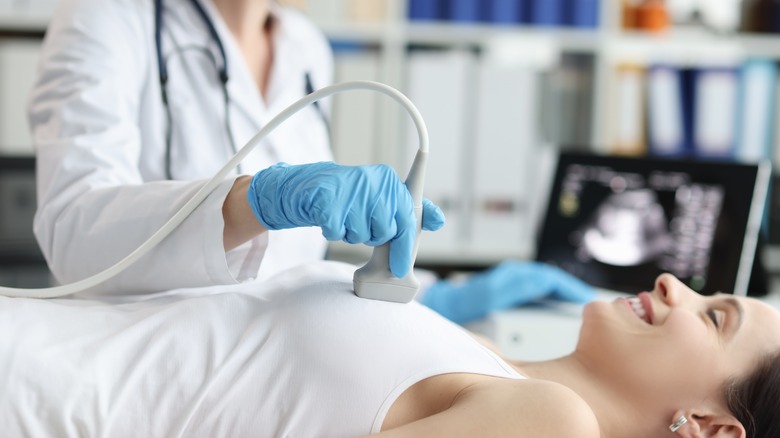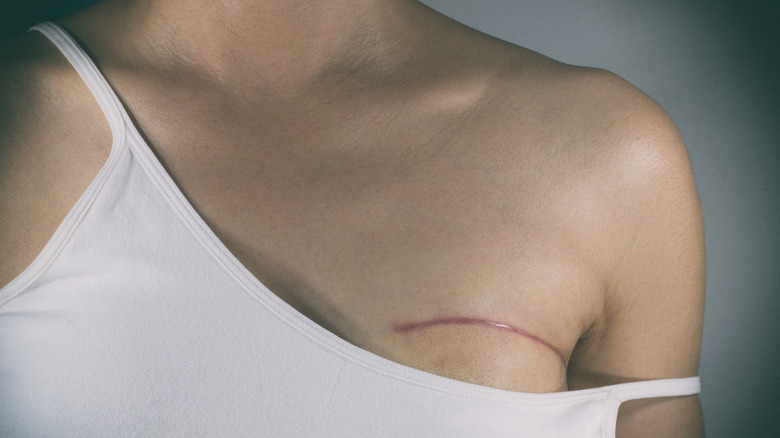What You Should Know About Paget's Disease Of The Breast
When most individuals think of symptoms of breast cancer, they think of finding unexpected lumps. Paget's disease of the breast is a rare form of breast cancer with a unique presentation.
According to the National Cancer Institute (NCI), Paget's disease of the breast is often misdiagnosed at first for other, more common conditions, such as dermatitis or eczema, since there is some overlap in symptoms.
However, mistaking a serious condition like Paget's disease of the breast with something more common, such as eczema, can cause a delay in diagnosis. This delay can result in individuals sometimes going months before the underlying cancer is discovered. A timely diagnosis is important so the disease can be treated sooner, before it has the chance to progress.
Here is what you should know about this type of breast cancer: its risk factors and symptoms, diagnosis and treatment, outcomes, prevention, and when to see a healthcare provider.
Risk factors, causes, and symptoms
Per NCI, most cases of Paget's disease of the breast occur in females, although males can get the disease too. While the average age at which a person is diagnosed is 57, it has been diagnosed in teenagers and people in their 80s.
According to Cleveland Clinic, some risk factors include being age 55 or older, having a family or personal history of breast cancer, and having inherited a genetic defect. You may also be more likely to develop the condition if you drink excessive amounts of alcohol or are overweight, have breast tissue that is considered denser than average, or have experienced radiation exposure to the chest.
Mayo Clinic lists several common symptoms of this cancer. Symptoms include flaky or scaly skin on your nipple. In addition, the skin on the nipple, areola, or both may be crusty and resemble eczema. There may also be itching or redness. Discharge from the nipple may be present and either straw-colored or bloody. Also, the nipple may be inverted. Additionally, there may be a thickening of the skin on the breast and feelings of tingling or burning on the breast. Generally, symptoms are only present on one breast.
It is unknown precisely what causes Paget's disease of the breast. Per NCI, a leading theory is that cancer cells from inside the breast travel through the breast's milk ducts to the nipple and areola. Another theory is that cancer originates on the nipple and areola themselves.
Diagnosis
The NCI explains that a nipple biopsy is used for diagnosis and there are several different types of nipple biopsies. Additionally, there may be instances when the entire nipple is removed for a pathologist (a specialized doctor who examines bodily tissues and fluids) to examine.
According to Mayo Clinic, Paget's disease of the breast is rarely confined to just the nipple. The breast contains a network of ducts and lobes. Those with Paget's disease of the breast often have ductal breast cancer, meaning the cancer is in the breast ducts. The two terms used to describe the type of ductal cancer are "in situ", meaning the cancer is in its original place, and "invasive", meaning it has spread to surrounding tissue.
To ensure a proper diagnosis and understanding of any cancer spread, the NCI explains a number of additional diagnostic procedures a healthcare provider may perform. These include a clinical breast exam as well as additional imaging, such as ultrasound exam of the breast, diagnostic mammogram, or magnetic resonance imaging. These procedures help the healthcare provider look for possible tumors.
Treatment
Part of treatment may include a type of lymph node biopsy, called a sentinel lymph node biopsy. This is performed to see if the cancer has spread to the lymph nodes in the armpit. Mayo Clinic explains this type of biopsy involves removing a limited number of lymph nodes to see if they have cancer. If they do, additional lymph node removal may be necessary.
The NCI describes treatment options and clarifies that there is no one size fits all for treatment. Historically, healthcare providers have performed a mastectomy, or full removal of the breast(s). They may have also removed axillary (armpit) lymph nodes too.
However, current practice depends on the individual and disease course, and breast-conserving surgery may be an option. This is typically for those without a lump that a healthcare provider can feel or see on a mammogram. Breast-conserving surgery involves removal of the nipple, areola, and cancer. It is combined with whole-breast radiation therapy. The NCI also states that depending on the characteristics of the cancer, other therapies, such as chemotherapy or hormonal treatments, may be used.
Prognosis and outcomes
The NCI's Surveillance, Epidemiology, and End Results (SEER) Program examines statistics related to various cancers. The five-year relative survival rate for those with Paget's disease of the breast, between 1988-2001, was 82.6%, slightly lower than that of breast cancer in general, according to the NCI.
While there is not more recent data from the SEER program for Paget's disease of the breast, a study published in the journal Breast Disease in 2020 examined the five-year survival of a cohort of nearly 7,000 patients who were treated surgically for Paget's disease of the breast between 2004 and 2015. This particular study found the five-year survival rate in their group to be 82.5%.
The NCI explains there are a number of factors involved in the prognosis and outcome, including if tumors are present in both breasts, just one, or neither; if the tumors are in situ or invasive; the stage of cancer; and if the cancer has spread to lymph nodes.
Additionally, the NCI clarifies when Paget's disease of the breast is combined with invasive breast cancer in the same breast, the five-year survival rate decreases with advanced stages of cancer (stage 1 being the least invasive with the highest survival rate and stage 4 the most invasive with the lowest survival rate).
Prevention
While some risk factors for Paget's disease of the breast are not modifiable, such as your genes, Mayo Clinic lists several factors you can modify to minimize your risk. These include exercising regularly, limiting alcohol, eating a healthy diet, and maintaining a healthy weight. Mayo Clinic also recommends if you are postmenopausal and on hormonal therapy, to discuss the risks and benefits with your healthcare provider, as combination hormonal therapy might increase your risk. When hormonal therapy is stopped, the risk decreases.
If you have concerns over changes to your breasts or nipples, reach out to your healthcare provider for help. Some of the symptoms, such as itching or irritated skin, may seem minimal. However, if these symptoms last longer than a month, or you notice a lump in your breast, your healthcare provider is a great resource for next steps. Your doctor can also provide guidance with lifestyle changes if you are looking to safely begin exercising, lose weight, or need help decreasing your alcohol consumption.






